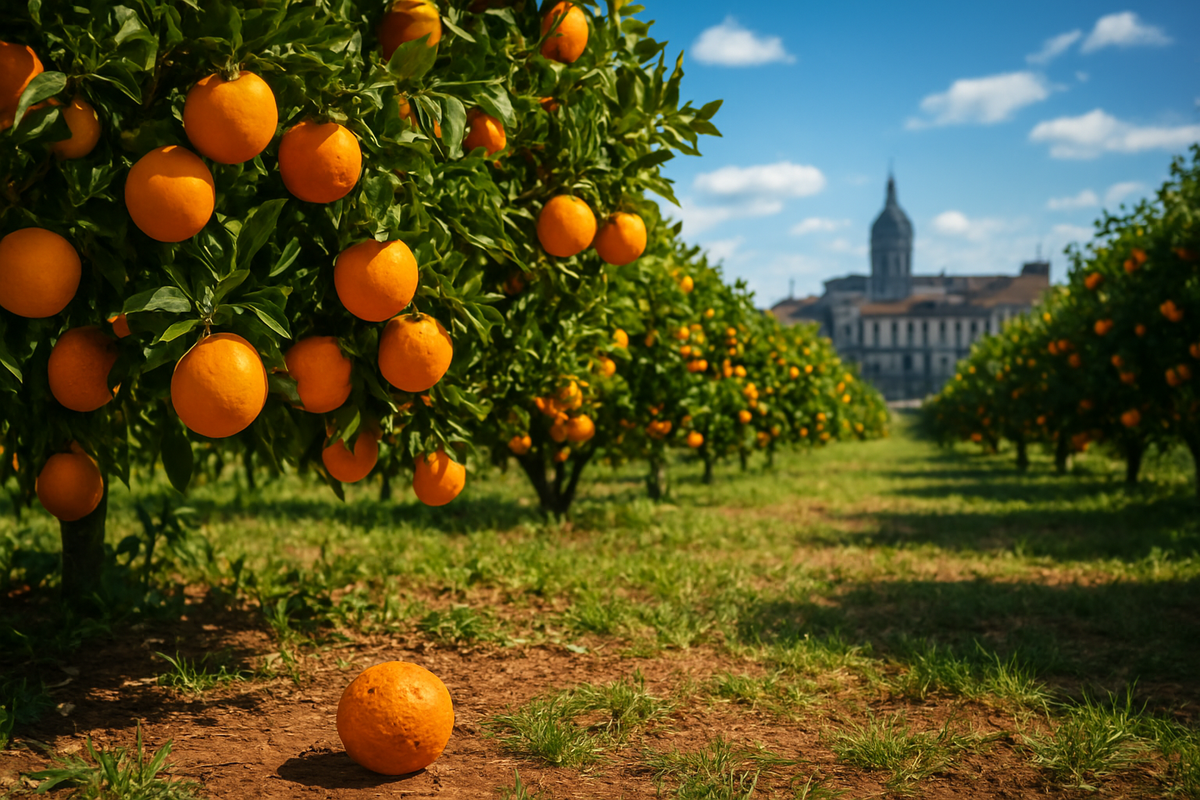European Demand Dips, Squeezing São Paulo Orange Prices Amidst 2025/26 Season Optimism

São Paulo, Brazil – November 13, 2025 – The latest ESALQ Citrus Analysis report reveals a significant downturn in European demand for Brazilian oranges, exerting considerable downward pressure on prices in São Paulo, Brazil. This development comes despite generally positive initial perspectives for the upcoming 2025/26 orange season, creating a complex and challenging immediate landscape for Brazilian growers and exporters. The subdued international interest, particularly from Europe, has led to a cautious approach by the São Paulo crushing industry, resulting in lower spot market prices for fruit destined for processing and a subsequent overflow into the fresh fruit market, further depressing prices for producers.
The immediate implications are stark: orange prices for industrial processing have seen a notable decrease, and even the in natura (fresh fruit) market is feeling the pinch. This situation underscores the delicate balance of global supply and demand, where even the promise of a healthier future harvest cannot immediately offset current market weaknesses. As the 2025/26 season approaches, the industry grapples with the paradox of potential recovery in production against a backdrop of flagging international appetite.
Detailed Market Dynamics and a Shifting Timeline
The ESALQ Citrus Analysis, often corroborated by data from CEPEA (Center for Advanced Studies on Applied Economics), provides granular insights into the current market pressures. Between July and October 2025, Brazilian orange juice international sales fell below expectations, with November shipments anticipated to continue this sluggish performance due to slow European acquisitions. This limited demand has directly influenced São Paulo's orange crushing industry, which has adopted a conservative purchasing strategy, primarily fulfilling existing contracts and acquiring additional fruit in the spot market at lower quotations, typically ranging from BRL 35 to BRL 38.00 per 40.8-kg box delivered to the industry.
This industrial caution has a cascading effect on the in natura market. With fewer oranges being directed to processing, an increased supply is being channeled to wholesale centers, predictably leading to downward price pressure for fresh fruit producers. Data from November 10 to 13, 2025, showed orange prices for industrial processing averaging BRL 39.95 per 40.8-kg box, marking a 12.59% decrease from the preceding period. Similarly, pear oranges in the in natura market experienced a 2.76% decline, closing at an average of BRL 58.61 per 40.8-kg box. Overall, Brazil's orange juice exports between July and September 2025 witnessed a 4.4% year-on-year decrease, predominantly driven by a significant nearly 23% drop in shipments to Europe during that quarter.
The timeline leading to this juncture is a confluence of environmental challenges, disease, and market reactions. Late 2023 saw Brazil's primary orange-producing regions endure prolonged high temperatures and widespread citrus greening disease, severely impacting production. By January 2024, scarcity had driven grower prices up. However, the 2024/25 growing season proved challenging, with Brazil's orange crop yield hitting its lowest in over 20 years due to severe heat and drought, leading to average prices three times higher than the previous year. While much-needed rainfall arrived in October 2024, the long-term impact on stressed orchards for the 2025/26 crop remained uncertain. Global orange juice prices peaked in January 2025 at an unprecedented $7,431 USD per ton. However, by the first half of 2025, Frozen Concentrated Orange Juice (FCOJ) prices, which had seen a sharp decline after August 2024 due to weakened demand, began to stabilize, signaling a cautious market awaiting the 2025/26 crop outcomes. The key players in this intricate web include Brazilian orange growers, major processors and exporters like Citrosuco, Sucocítrico Cutrale, and Louis Dreyfus Company (LDC), alongside European importers, retailers, and beverage manufacturers.
Initial market reactions have been characterized by price volatility. While earlier periods saw significant price surges due to scarcity, the current reports highlight a reversal, with prices being pressured downwards by reduced European demand. This has led to shifts in consumer behavior in Europe, with a decline in orange juice consumption and some beverage manufacturers adjusting product formulations to reduce orange pulp content. The persistent threat of citrus greening in São Paulo is also prompting a strategic reallocation of investments in orange cultivation towards other Brazilian states like Mato Grosso, Paraná, Goiás, and the Triângulo Mineiro.
Corporate Fortunes: Who Wins, Who Loses?
The current market conditions, characterized by low European demand and depressed São Paulo orange prices, will inevitably create winners and losers across the global citrus supply chain.
In Brazil, the major players are predominantly large, privately held companies like Citrosuco (private), Sucocítrico Cutrale (private), and Louis Dreyfus Company (LDC) (private), which dominate orange juice processing and export. For these vertically integrated giants, sustained low orange prices in São Paulo for the 2025/26 season present a mixed bag. Their grower segments would face decreased revenues from fresh fruit sales. More critically, their processing and export divisions, while potentially benefiting from lower raw material acquisition costs, are simultaneously contending with low international orange juice prices. Brazilian orange juice exports in early 2025/26 already saw a 15% decrease in revenue, even with only a 4% decrease in volume, indicating that lower selling prices for processed juice are squeezing overall revenues. This scenario suggests reduced profit margins and could exacerbate financial vulnerabilities, particularly for companies with high debt servicing costs.
Conversely, major European orange importers and companies that utilize orange juice as an ingredient are poised to benefit. Publicly traded entities such as large supermarket chains across Europe (e.g., Mercadona (BMAD: MER)) or global food and beverage giants like The Coca-Cola Company (NYSE: KO), PepsiCo, Inc. (NASDAQ: PEP), and Nestlé S.A. (SWX: NESN) would likely see a reduction in their cost of goods sold. Lower acquisition costs for fresh oranges and orange juice concentrate from Brazilian suppliers translate directly into improved profit margins. These companies can either pass on these savings to consumers to stimulate demand and increase sales volume, or retain them to bolster their profitability. For beverage manufacturers, this margin relief is particularly advantageous if they can maintain current retail prices while their ingredient costs decline, which would generally be viewed positively by investors, potentially leading to favorable stock performance.
Broader Significance and Industry Shifts
The low European demand for Brazilian oranges is not an isolated incident but a symptom of profound, systemic shifts within the global citrus industry. This event fits into broader trends of declining global orange production, largely driven by the devastating combination of climate change and disease. Extreme weather patterns, including droughts and heatwaves, alongside the relentless spread of citrus greening disease (Huanglongbing - HLB), are severely impacting major producing regions like Brazil and Florida. The 2024/25 Brazilian orange harvest, for instance, is projected to be the lowest in over three decades, with citrus greening affecting over 40% of Brazil's orange groves.
The ripple effects extend widely. Other orange-producing nations, such as South Africa, Spain, Mexico, and Egypt, might see increased demand as European importers seek alternative, more competitively priced sources. Brazil itself, facing high domestic orange prices and reduced local consumption, has already begun importing fresh oranges from countries like Argentina and Uruguay to meet internal demand, demonstrating how disruptions can alter established trade flows. Citrus juice processors globally face higher raw material costs and are compelled to innovate, reformulate products with alternative fruits or lower orange content to manage expenses and cater to changing consumer preferences for natural, fortified, and low-sugar beverages.
Regulatory and policy implications are also emerging. The potential long-term benefits of the Mercosur-European Union agreement, which aims to gradually eliminate export tariffs on Brazilian orange juice to the EU, could enhance Brazil's competitive position. However, stringent EU food safety and phytosanitary standards remain critical hurdles for market access. Furthermore, the crisis in orange juice supply has prompted discussions within industry bodies about lobbying for changes to UN-level food regulations to allow orange juice to contain other citrus fruits, reflecting the scarcity and high cost of pure orange concentrate.
Historically, the citrus market has seen similar disruptions. The decline of Florida's citrus industry due to hurricanes and greening offers a stark parallel to Brazil's current challenges. Previous freeze events and major production shocks, like those during the Spanish Civil War, have also led to significant price surges and global supply impacts, underscoring the inherent vulnerability of this agricultural commodity to environmental and biological threats.
Navigating the Future: What Comes Next
The outlook for the global citrus market is characterized by continued volatility, with both short-term and long-term possibilities for orange prices and demand. For the immediate 2025/26 season, while Brazil's orange crop is forecast for a significant rebound (initially projected at 314.6 million boxes by Fundecitrus, though later revised slightly downward to 306.74 million boxes due to fruit drop and rainfall deficits), prices are expected to remain above long-term averages due to below-average global juice inventories and rising production costs in Brazil (estimated 15-16% increase). Demand, while projected to grow globally, remains sensitive to price increases, with a continued shift towards fresh, nutrient-rich, and "not from concentrate" (NFC) orange juice.
In the long term, orange and orange juice prices are projected to maintain an upward trend, potentially reaching $600-$700 per ton within 3-5 years if structural supply issues like citrus greening and adverse weather persist. The global orange market is expected to grow steadily, driven by increasing demand for vitamin C-rich fruits and the expansion of citrus farming in suitable climates, with Asia-Pacific emerging as a key growth region.
Brazilian orange growers and exporters must implement strategic pivots. Foremost is combating citrus greening (HLB) through investments in disease-resistant varieties and innovative agricultural solutions. Geographical diversification of cultivation to less affected states like Mato Grosso and Paraná is also crucial. Cost management, efficiency improvements, and market diversification into premium, organic, and functional orange juice products are vital for maintaining profitability and capitalizing on evolving consumer preferences. Furthermore, navigating complex trade policies, such as the 10% US tariff on Brazilian orange juice, may involve exploring collaborations for USMCA-compliant juice blends.
Market opportunities include the chance for Brazil's rebounding production to replenish global inventories, growing global demand for citrus, and the lucrative premium segment. However, significant challenges remain: the persistent threat of HLB, climate volatility, high production costs, low global inventory levels, consumer price sensitivity, and ongoing trade barriers. Potential scenarios range from an optimistic recovery where HLB is managed effectively and production rebounds strongly, leading to stable but elevated prices; to a moderate volatility scenario (most likely) with partial recovery tempered by disease and weather, keeping prices elevated; to a pessimistic supply crisis with intensified greening and severe weather leading to record-high prices and a radical restructuring of the global citrus industry.
Comprehensive Wrap-Up and Investor Watchpoints
The ESALQ Citrus Analysis report underscores a critical moment for the global citrus market. The immediate pressure on São Paulo orange prices due to low European demand highlights the market's sensitivity to international trade dynamics. However, the overarching narrative remains one of persistent supply constraints driven by the twin threats of citrus greening and climate change, which have severely impacted production in key regions like Brazil and Florida. While a rebound in Brazilian production for the 2025/26 season offers some relief, global orange juice stocks remain critically low, suggesting that underlying supply-side pressures will continue to exert upward influence on prices in the medium to long term.
Moving forward, the Brazilian citrus market faces the arduous task of rebuilding its production capacity amidst ongoing environmental and biological challenges. The global citrus market, in turn, must adapt to a new normal of elevated prices, potential supply chain disruptions, and evolving consumer preferences. The lasting impact of these events will likely be a more geographically diversified citrus industry, increased investment in disease-resistant varieties and sustainable farming practices, and a greater emphasis on value-added and premium orange juice products.
Investors in the citrus commodity market should closely monitor several key indicators in the coming months. These include: signs of recovery in European demand, new crop forecasts from Brazil's Fundecitrus and ESALQ, global production reports from other major citrus nations, and critically, updates on orange juice stock levels. Developments in combating citrus greening disease, changes in trade agreements (like the Mercosur-EU deal), and unpredictable weather patterns in key growing regions will also be pivotal. Finally, tracking the performance of frozen concentrate orange juice futures will provide valuable insights into market sentiment and expectations for future supply and demand. The citrus market is in a period of significant transformation, demanding vigilance and strategic adaptation from all stakeholders.
This content is intended for informational purposes only and is not financial advice



